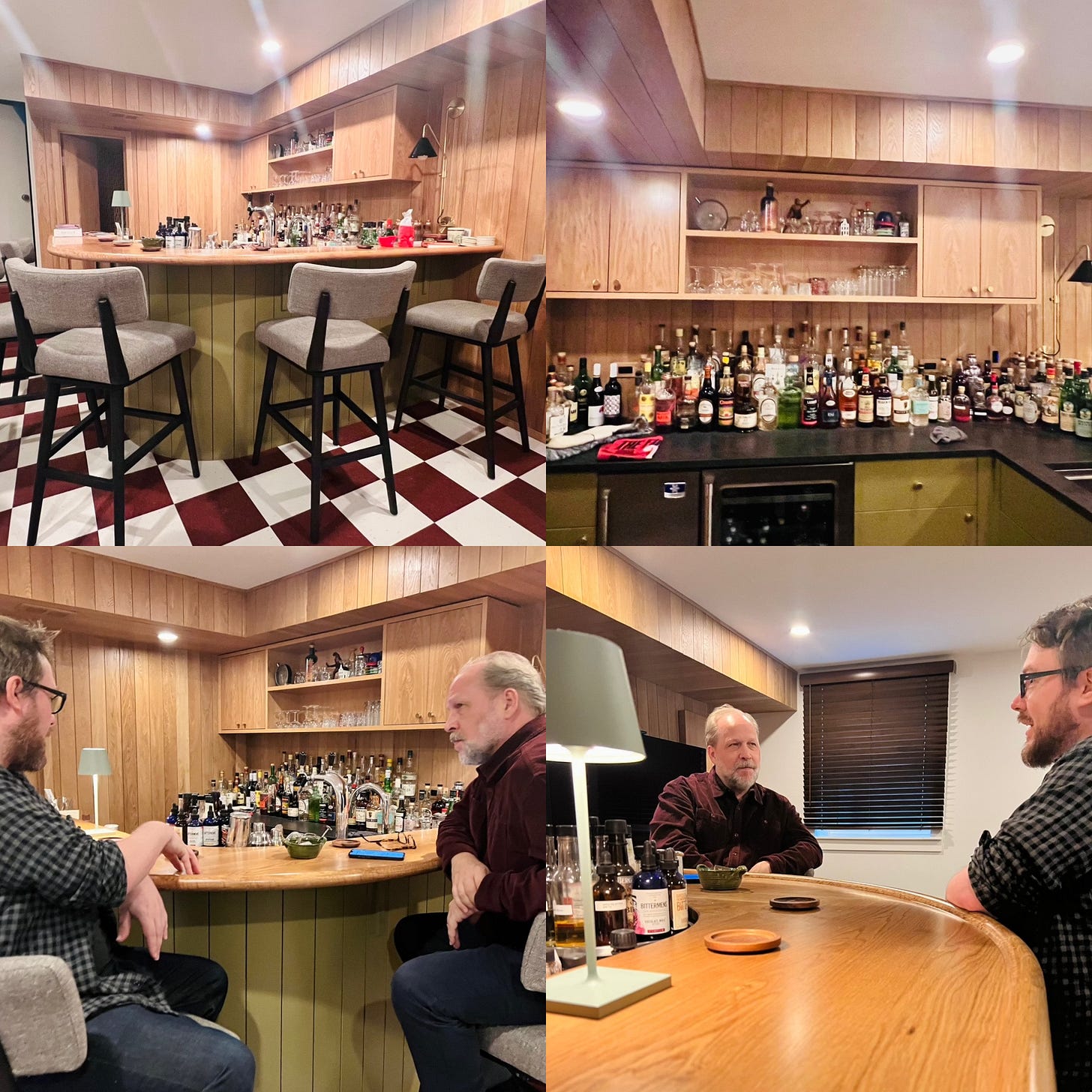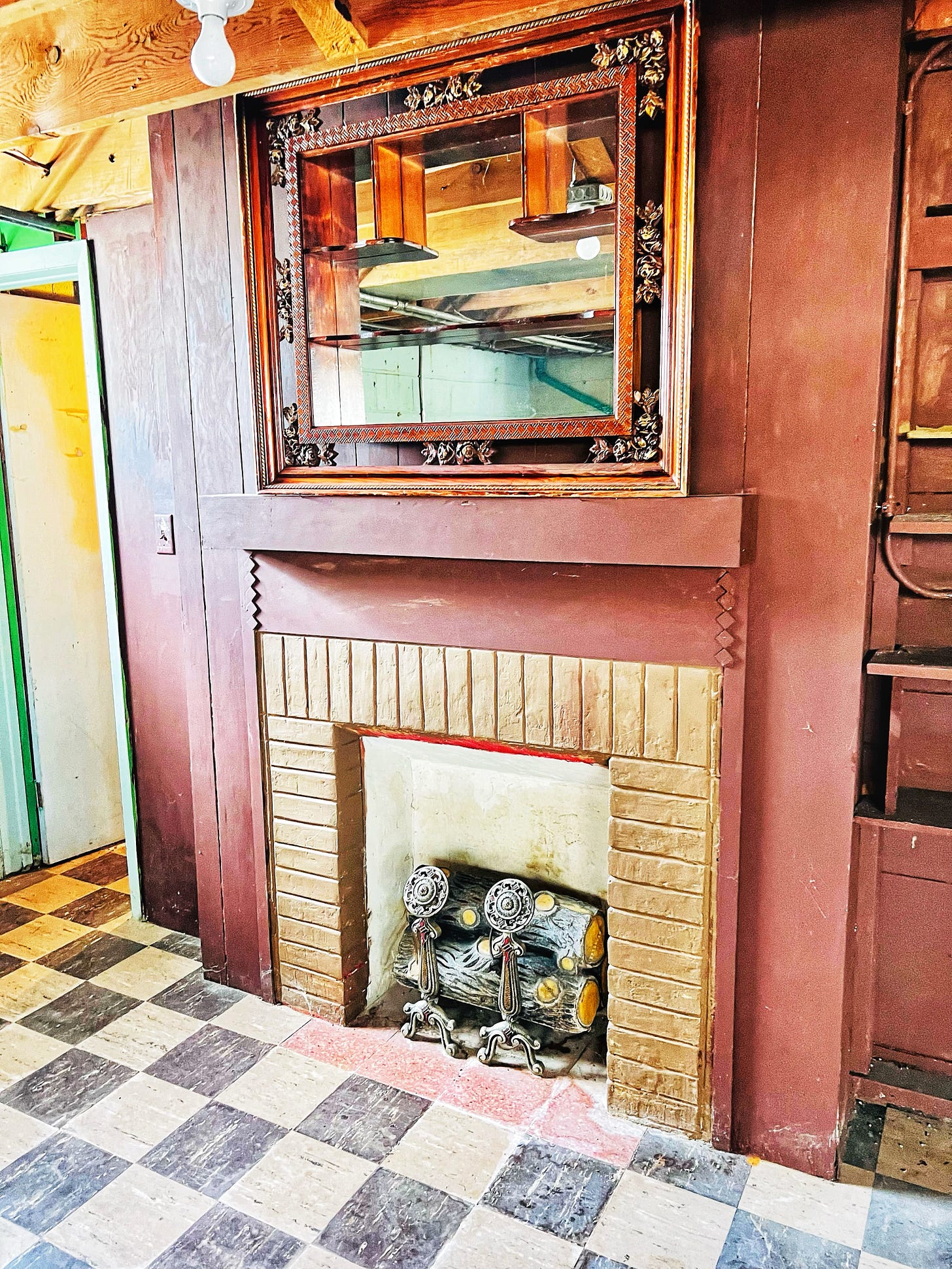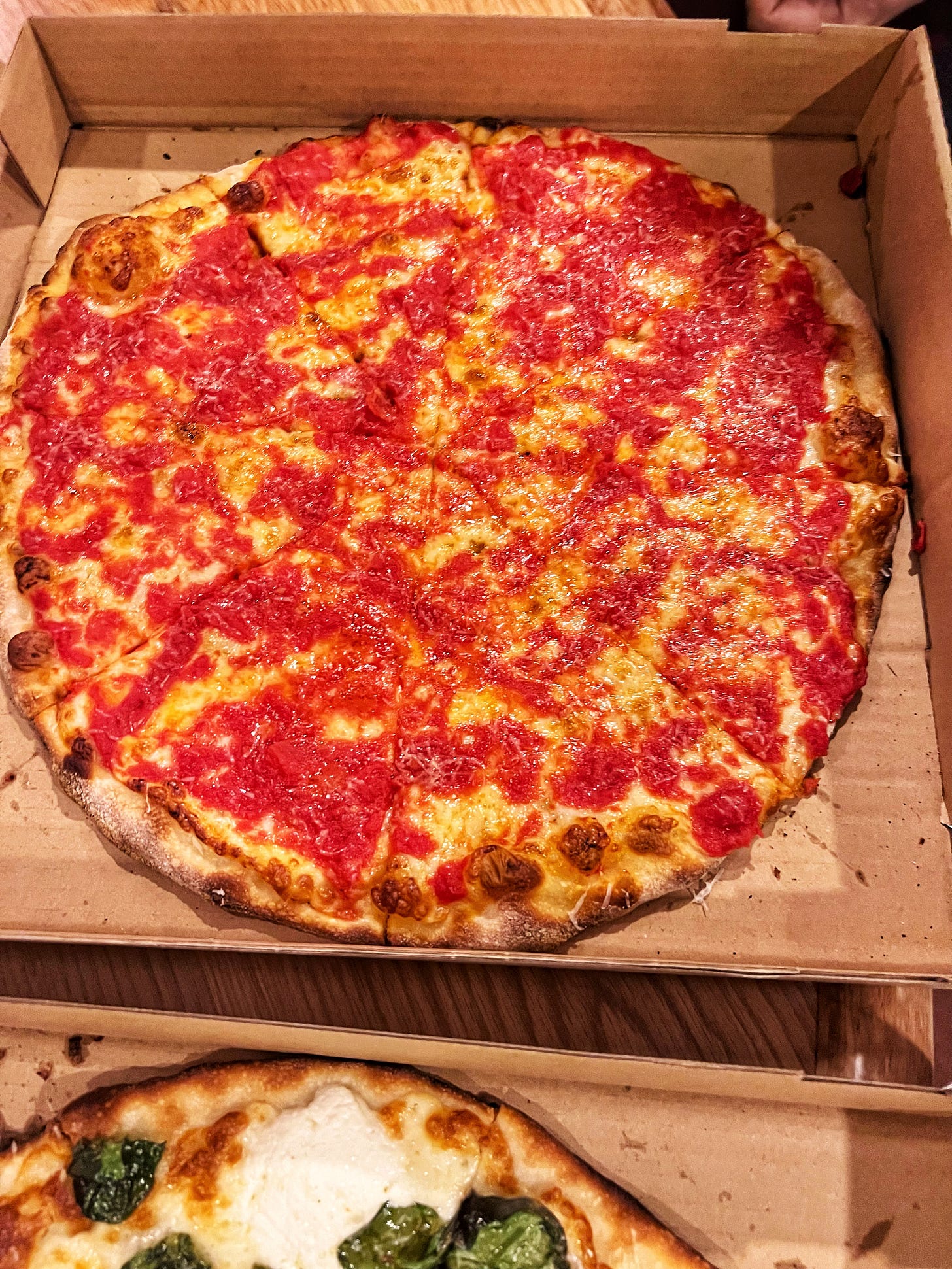At Home With: Jesse Casey and Sarah Bishop-Stone
In This New Column, The Mix Makes a Visit to One of Philly's Newest Home Basement Bars and Explores the History of the Home Bar.
It should come as no surprise that we love home bars at The Mix. In this new feature we’ll spend some time At Home With home-bartenders, bartenders, bar owners and writers in their home bars. Some bars are in basements, some not, but each is unique and, wherever they are, you are sure to get a good drink and some interesting conversation.
We’ve been looking for a house for the past few years. We’ve mostly looked in upstate New York, Pennsylvania and Wisconsin, Robert’s home state. While looking in Wisconsin it became apparent that there is one thing you can always expect to find while house shopping there: a basement bar.
So. Many. Basement. Bars. Really, you have no idea.
The more mid-century the house, the greater the chance that it would have a basement bar. When looking at some of the little grandma houses from the outside, we just couldn’t imagine what lay in wait in the basement. Sometimes we were tempted to buy a house just because of the bar inside it.
Wisconsin is one of the booziest states in the country, and so it stands to reason that its inhabitants consider a basement bar a must, like a basketball hoop in the driveway or a walk-in closet in the master bedroom. Robert said growing up in Wisconsin every inch of available space was used, basements included. He often spoke of how every holiday the cousins were sent to watch television on some old couch deposited in the basement. Sometimes the basements were renovated and sometimes not, but the basement was the child equivalent of the third space in Wisconsin. And a lot of the time, it was the Dad’s equivalent, too.
The History of the Home Bar
Prohibition—which had so much to do with so many innovations in modern drinking history—had a lot to do with home bars. Speakeasies were not just found in clubs or restaurants at the time; they were also in people’s homes or boarding houses, where booze could be served with less fear of reprisals from the law. And the most logical place for a bar to go unnoticed was the basement. So both public and private basement bars were born.
When World War II ended, returning soldiers were aided by the government in buying homes (my uncle bought one for $1 down) and then they were encouraged to get married and start families in these new homes. The cocktail party was popularized and couples entertained in their living rooms, where cocktails were served from bar carts— originally tea carts (I still have my parent’s).
After dinner, just like their Victorian predecessors, mid-century men adjourned to their home bars, whether they were in the study, the den or the basement. (Robert’s Uncle Ed’s home bar was in the study; his Uncle Fred’s bar was in the family room; and his Uncle Dean’s bar was in the basement.) These were the original man caves.
The farther families moved into the suburbs, the farther they were from a local bar, and the more important home bars became. And if your home was not big enough to have a den or a study, you most likely had a basement with space enough for a bar.
Fast forward to today. As these mid-century home-barkeeps aged and cocktails faded into the sunset, home bars were repurposed to hold laundry, spare holiday decorations or outfitted with the kid’s new wide-screen television. When my friend Kathleen MacLaughlin was growing up, her parent’s old home bar was used as their play room. There was a mural of Lake Erie and a curved wooden bar and the girls pretended they were on a ship. As the four MacLaughlin sisters became teens, the play room became a make-out room—but still no cocktails were served.
Now, twenty-first century young homebuyers vie for old homes that still have their vintage bars, and non-homebuyers peep on Instagram sites like Vintage Basement Bar. Some lucky ones build bars of their own design.
Which brings us to the homeowners featured in this initial column.
Jesse Casey and Sarah Bishop-Stone
Jesse Casey runs a small animation studio, working mostly on advertising. He’s amassed an amazing amount of cocktail knowledge while working on a cocktail-centered game. Sarah Bishop-Stone is a creative organizer and producer. They live in Philadelphia, where Bishop-Stone is from, but prior to that they were both in Brooklyn, and way before that, Jesse grew up in Baltimore.
Oddly enough, neither of them had a home bar before, let alone a basement bar. But they both instantly connected to the South Philly mid-century aesthetic, which reminded Jesse of his Baltimore roots—older houses renovated with wood paneling, linoleum, carpets, etc., taking advantage of every bit of the square footage possible. (One of the sites they like to frequent is South Philly Time Capsules, a fun Instagram account that takes you on a vintage joy ride through South Philly and beyond.)
But I’m putting the bar before the cocktail here. How did Jesse and Sarah become interested in cocktails? Jesse had a college roommate from Kentucky who introduced him to Bourbon—things like Van Winkle Special Reserve, which was affordable at the time. Drinking Bourbon in college was his gateway to the Manhattan cocktail. After he started making his own Manhattans, Jesse began fiddling around to see what else he could cook up. Then there was no turning back.
”I got a bottle of vermouth to mix the Manhattans and then looked up what else I could make with it,” he said. “I didn’t really know what I was doing, though. I think the only tool I had was a shaker and I was probably eyeballing all my measurements. I got a few other ingredients to play with, but I never really understood why my home drinks weren’t as good as the ones I ordered at bars and restaurants.”
In his early cocktail discovery days, Jesse explored restaurants with interesting cocktail lists like Rye and Char No. 4 in Brooklyn.
Enter bartender Sother Teague. Jesse happened to be getting into cocktails about 2011, right when Teague’s bar Amor y Amargo opened in Manhattan. As a gift, Sarah gave him cocktail classes with Sother. That set him on the path to where he is now in his beautiful home bar in Philadelphia.
Jesse said that taking the class managed to pull together his understanding of how to make cocktails, but also taught him what was going into the cocktails that he saw on bar menus. This helped him to not only make cocktails at home, but to plan the bar that they would build in the future.
Around 2014 Sarah moved to Philadelphia, so the couple spent quite some time commuting between Brooklyn and Philadelphia. Then Covid happened. In March of 2020, when Jesse was on his way to Philly, he got sick. He was out of commission for a few weeks. Then his company went remote. Suddenly the two of them were looking for a bigger place in Philly.
Covid did more than just give us Ina Garten and Stanley Tucci making spurious cocktails at home. It encouraged everyone to make cocktails at home. People were drinking more and devoting time to figuring out what to do with the bottles they bought. Suddenly there were cocktail videos, cocktails classes, and zoom happy hours everywhere. Jesse had a big head start on everyone in the cocktail department and when he and Sarah found the right home, they began dreaming up their home bar.
“We didn’t have a direct personal connection to the basement bars, just an appreciation for our neighbors’ quirky houses,” he said. “And when we decided that we were going to build our own bar, we wanted to nod toward that tradition.”
Building the Bar
Renovations on Bishop-Stone and Casey’s new house finished in February of this year. They were not quite all the way moved in when we dropped by in early April. But the bar was fully functional and ready for us.
The road from a Costco-type metal shelving unit to a hand-made wooden bar was long—about two and a half years—but worth it. When they bought the house, the basement was filled with the previous owner’s junk (the top photos seen below). They had to clear it all out, then lower the floor (the bottom two images below). The front window was enlarged, because now that this was livable space, they needed an emergency exit in order to meet code.
Luckily, Sarah and Jesse had similar tastes and a shared vision. They wanted a modern home bar, but one that nodded heavily to the tradition of the mid-to-late-20th century, South Philly bars, with wood paneling, linoleum tile floor, the works. They found an architect and designer team who understood what they wanted, Eric and Sary at (re)work Architecture and Design. The general contractor was Joe Smart at S&J Concepts and the beautiful hand-done millwork bar and cabinets were by Doyle Design.

When they were planning out the bar, they knew they wouldn’t have space for a dishwasher, so Jesse was hoping for a glass rinser to pick up some of the slack. Sary found a combo sink with the rinser that even served as a drip tray for the seltzer tap.

Both Jesse and Sarah were a huge part of the project, not just describing what they wanted, but in researching items for the bar like the Manitowoc ice machine. Jesse wanted this machine, but did enough research to understand that the sale machine he found was right for the space because it also had the drain pump they needed because of the basement elevation. They had their eyes open to the necessities of the project and participated throughout—the key to happy homeowners.
Jesse and Sarah are really happy with the how the bar turned out. And though they haven’t had tons of company yet—Jesse said they’ve had a series of “soft openings” so far—they are now almost completely moved in and ready to spend a lot of time there with friends and family. And hopefully us too, as the food and drinks were top notch.

Bar Pizza
Like any great bar, this bar had phenomenal bar food. Sarah ducked out and came back with these two beauties from CJ & D’s Trenton Tomato Pies, which is housed inside Cartesian Brewing on Passyunk Avenue. Jesse said that the wait can be long and they stay open only until they sell out of dough. You can visit them on Instagram at @CJDtomatopies. I highly recommend anyone in the area try these pies.
Cocktails
Of course, this bar had excellent cocktails. And, like any great bartender, Jesse had a conversation with Robert about the first drink. They decided upon Jesse’s riff on the Matador cocktail as printed in the Cafe Royal Cocktail Book, printed in London in 1937 and written by bartender W.J. Tarling. The Matador is an equal parts drink using Tequila, dry vermouth and curaçao and represented an early creative use of the agave spirits in cocktails. (For whatever reason, there are a lot of Tequila cocktails in the Cafe Royal book.) Jesse adjusted the recipe, upping the amount of tequila. He also added a few drops of saline solution to make the drink pop.
Jesse served the drinks in some Nick and Nora coupes. The Matadors were delicious. We’re going to have to make them more at home.
Matador
W.J. Tarling, Cafe Royal Cocktail Book, 1937, adapted by Jesse Casey
2 ounces La Gritona reposado Tequila
3/4 ounce Noilly Prat Original Dry vermouth
3/4 ounce Pierre Ferrand Dry Curacao
4 drops saline solution (1:4) or a pinch of salt.
Combine cocktail ingredients in a mixing glass half filled with ice. Stir content until chilled. Strain into chilled Nick and Norah glass, garnish with a lemon twist.
Jesse Casey’s Super Juice
While we were there, Robert and Jesse got to talking about Super Juice. I saw a bottle in the beautiful bar fridge. We found out Jesse makes his own at home—and he made us a sour with it. It was delicious. So, we asked if he’d share his recipe below and being the kind of guy that he is, he said yes! So here it is below in his own words.
“I'm happy to share my super juice formula, but I wouldn't call it my own. It's an amalgamation of techniques cribbed from various internet sources, and I don't want to claim I invented anything. From what I understand, Nickle Morris came up with the original technique, and a bunch of cocktail YouTubers have been experimenting and adjusting their own formulas. I got interested in it after years of making summer batches of Toby Cecchini's lime cordial, which has a somewhat similar process.”
Here's how he’s been doing it.
Ingredients
A few lemons or limes
Citric acid powder (and malic acid powder for lime)
Sugar
Salt
Equipment
A precise kitchen scale accurate to tenths of a gram
A citrus peeler
A citrus juicer
A nut milk bag or fine strainer
A blender
Instructions (in Jesse’s words)
First, you wash and peel your citrus and remove as much pith as you can. Set the peeled fruit aside for later.
Then, weigh the peels. The final weight of your super juice will be 10 times the weight of the peels.
Grab a calculator and determine the weights of the rest of the ingredients based on that total weight using these ratios:
6% acid powder (all citric for lemon, 2:1 citric:malic for lime)
2% sugar
.25% salt
91.75% water
I've played around with trace amounts of other ingredients from Modernist Pantry (succinic acid, potassium sorbate, and other scary names), but I'm not sure if they're worth the effort.
Combine the dry ingredients with the peels until evenly covered, and set them aside for an hour or two to draw out the oils. Recently, I've been doing this in vacuum bags, but it works just fine without the vacuum, too.
After the oils have been drawn out from the peels, dump them into a blender with the water and blend until the peels are broken up and the oils are emulsified.
Filter out the solids through cheesecloth or a nut milk bag. You should have a slightly cloudy, pale yellow or green liquid that tastes pretty much like citrus juice, though maybe with a little less body.
Juice the peeled citrus and add the juice to the mixture and stir it all together.
That's it. That's super juice.
It seems to keep its flavor for a week or two in the fridge before starting to degrade. So I break it out into 375 ml portions for the freezer, and thaw one at a time.
It's not exactly the same as fresh squeezed, but it's pretty close (much, much better than bottled juice from the grocery store), and very convenient. Great for a week at a beach house.
—Jesse Casey
So long from South Philly!
It was great to visit Jesse and Sarah at home. I loved their research, creativity and patience! After working for architects for years, and watching projects progress, especially when there are big interior projects, I realize how much goes into a project like this and they’ve done an amazing job.

Odds and Ends…
Yours truly made the cut for the top four nominees for the Spirited Award for Best Cocktail and Spirits Writing at Tales of the Cocktail this year. The nomination was for my “Bar Tab” column about the Martini for The Wall Street Journal. The Awards ceremony will be on July 24 in New Orleans… Several other paid subscribers to The Mix made the top four in their respective categories, including Nicola Nice, Aaron Goldfarb, and Anistatia Miller & Jared Brown (Best New Book on Drinks Culture, History, or Spirits); Colin Asare-Appiah and Meaghan Dorman (Best U.S. Bar Mentor); Radio Imbibe and VinePair’s Cocktail College (best broadcast or podcast); and Jim Meehan (Best New Cocktail or Bartending Book)… The Timeless Awards, which honor longstanding cocktail bars, and which were co-founded by myself and David Wondrich in 2019, were given to Bar Cock in Madrid, Spain (International) and The Bar at Keens Steakhouse in New York (U.S.)… The Minnesota-based importing house Haus Alpenz has four new liqueurs worth checking out: Sevez Honey Lavender Liqueur, Alpeggio Hay Liqueur; Rothman & Winter Orchard Quince Liqueur; and Chambéryzette Strawberry Aperitif. I recommend them all unreservedly, but particularly the strawberry vermouth and quince liqueur… There is now a Chinese restaurant chain in the old La Grenouille space in Manhattan. Sigh… The New York Times has decided to stick with the whole two-restaurant-critics set up. This week, they named Tejal Rao and Ligaya Mishan as its new co-chief restaurant critics. Mishan will cover New York. Rao will cover most everything else… The great new restaurant at Industry City in Brooklyn, Confidant, is now serving lunch. And they have a Juicy Lucy on the menu! The Juicy Lucy, a regional specialty hamburger in Minneapolis, was the subject of an early 2022 post on The Mix. Check it out.












That was a lovely afternoon. And that Matador cocktail was excellent.
I can’t wait to start working on our home basement bar!